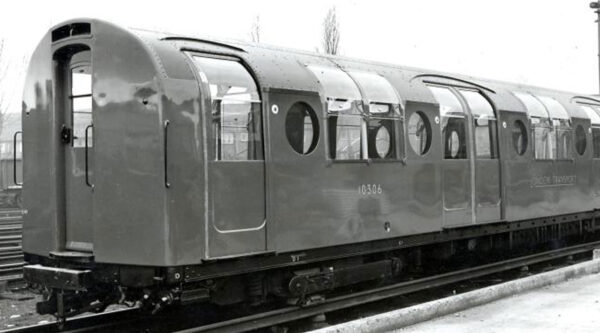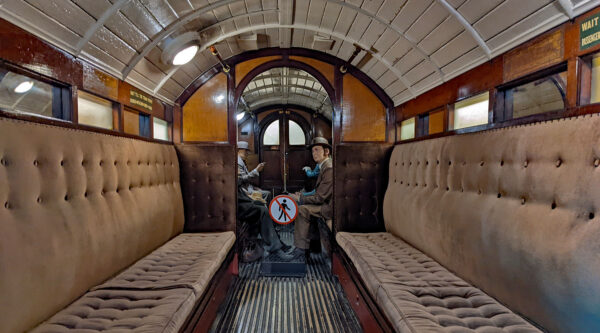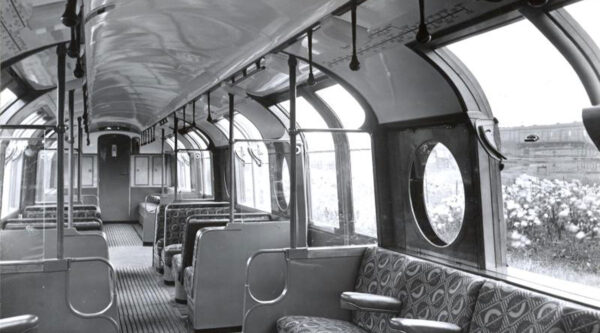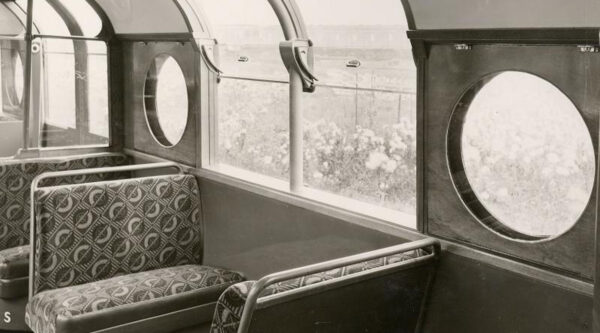It’s December 1949 and an experimental tube train has been introduced on the London Underground — that had huge windows and portholes.
This was a converted 1938-stock train, officially number 10306, and it was to test the public’s reaction to having windows that were not the usual rectangular windows that trains came with at the time.
First shown off to the media in the middle of December, the train made its first trips the following week, commencing 19th December 1949[1].
The history of windows on tube trains is a curious one. While the original trains on the sub-surface lines had windows as they were based on existing mainline train designs, when the first deep tube tunnel trains were introduced, they had hardly any windows at all.
At the time it was thought that with nothing to look at in the dark tunnels, people wouldn’t want windows, and as there was a guard at the end of the carriage to call out station names, there wasn’t much need for them either. So the first trains were introduced with just tiny slots at the top, and by modern standards, fairly dim light bulbs inside. Soon nicknamed the padded cells they were hugely unpopular and it wasn’t long before the London Underground had put windows into the carriages.
The later trains came with modest-sized single-pane windows which allowed a decent view outside, which became increasingly appreciated as the London Underground expanded and started being less under the ground than running above it.
Thoughts turned to how they could offer bigger windows. Now London Underground wasn’t one for wholesale changes and even things that look and sound like good ideas can sometimes have the most unexpected failures when the public see them. So in November 1949, London Underground took an existing 1938 tube train carriage and at the Acton Works[2] retrofitted it with new huge windows.
Variously nicknamed the Sunshine or Vista car, three significant changes were made to the carriage.
The central windows in each bay of seats were increased in height by curving them at the top around the curved body of the carriage. The same effect was extended to the doors as well, with the advertised benefit that people wouldn’t need to bend down to see what station they were at[3].
While the curved glass in the doors was technically the most challenging change to the design, the most distinctive change as seen by modern eyes was the inclusion of porthole windows. These replaced larger windows that had been there as the smaller windows were needed so that more metal structure could be introduced alongside the large curved windows to stop the carriage body flexing too much[4]. A notable feature of the large windows was that the glass was curved, which is still used today, even though it tends to require levels of higher maintenance[5].
Having run on the Bakerloo line since February 1950, the experimental carriage went to the Northern line in March 1951 and stayed there until it was withdrawn for use as a pilot unit in January 1978 to work with the 1973TS ETT unit. It was last used for that in January 1979 and was cut up at Ruislip in March 1980.
Part of the reason why the experiment with the curved seating windows was not extended or reused in modern tube trains is that for all their benefits, they had a major downside – they let in too much heat in the summer months. And without air-conditioning, that made the carriage particularly unpleasant to ride in.
The curved glass in the doors though was considered to be a success and was first introduced in a full fleet of trains in 1967 on the Victoria line, but no to the curved seat windows. And the portholes went as well.
Additional sources
1] The Sphere – Saturday 31 December 1949
3] Daily Mirror – Wednesday 14 December 1949
4] The History of the Bakerloo Line by Clive D W Feather
5] London Underground News – January 2012











I travelled on 10306 as a schoolkid. I believe it was called the Astral car then, although the curved door windows were so standing passengers could see station names more easily rather than the stars!
I’d always assumed that the reason why the Central Line trains look so gloomy from the outside is that the glass is tinted to reduce the heat, and so much if the line is above ground. Though it could just be dirt.
It’s a tint, one of many design decisions on that stock that would have been questionable singly but proved disastrous collectively. See also the destination indicators that dissolved in sunlight and the awkward kink in the seating.
I remember travelling in a porthole carriage going to school on the Northern Line in the 60s.
The porthole carriage was also in use on ‘The Drain’ – Waterloo and City Line – in the late 1960s.
Don’t I remember the padded cells on The Drain sometime around 1980? It did occur to me at the time that with only two stations, all undergroud, windows wouldn’t have been useful.
The porthole carriage can’t have been used on the Waterloo & City line. That was British Railways’ responsibility and used an incompatible system until rebuilding in the 1990s, when Central line clones were introduced; just in time to transfer the route to London Underground in 1994.
The portholes did not replace larger windows, as they were in the door pockets, which previously did not have windows at all. They were undoubtedly circular for the reason stated, i.e. so as to leave as much metal in place as possible, to keep the strength.
Those interior photos are gorgeous! What a design beauty. A shame they resulted in interiors being overheated.